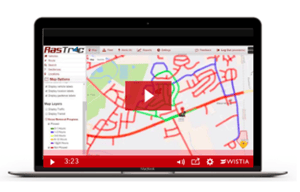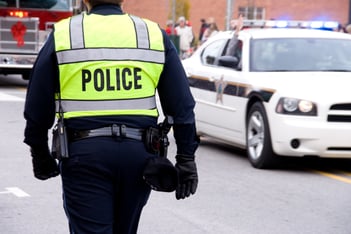A public safety fleet manager is a highly specialized and active role that requires skills and knowledge that are commonly acquired through years of experience. As such, fleet managers often have limited time available for trying to figure out ways to implement new processes, increase efficiency and safety, and save money. This is especially challenging for fleet managers who do not utilize a GPS tracking solution for fleet management as part of their operations.
There are many reasons why fleet managers need an agile and reliable fleet management solution. The uses of GPS tracking are virtually limitless and can make your professional life significantly easier.
To help simplify your fleet management efforts, we’ve put together this blog as a resource detailing how some uses of GPS tracking can solve many public safety fleet management issues.
How to Improve Fleet Patrol Route Coverage and Efficiency
Effective GPS fleet tracking solutions offer a variety of benefits and are vital to improving fleet efficiency. Modern GPS tracking devices, in conjunction with agile tracking software, provide you with the highly accurate location data and other actionable information that you need to simplify everyday tasks while also increasing the safety of your personnel and the community at large.
Having the right fleet management software, in conjunction with reliable GPS tracker devices, can help you:
- Actively monitor and track vehicles and their drivers in real time
- Optimize driver routes
- Access up-to-date, accurate data
- Monitor vehicle activity and usage, including fuel use and idle times
- Automate critical daily, weekly, or monthly reports
- Schedule vehicle maintenance reminders and notifications
 Using Rastrac’s versatile and fully customizable StreetComplete tool, public safety fleet managers can quickly and easily track what areas are patrolled, when, and by whom. When a vehicle patrols or services a particular area, the route will display on a real-time, color-coded map that shows the task is complete. However, as time goes on, the route “ages” and changes colors, detailing how long it has been since that area was last serviced.
Using Rastrac’s versatile and fully customizable StreetComplete tool, public safety fleet managers can quickly and easily track what areas are patrolled, when, and by whom. When a vehicle patrols or services a particular area, the route will display on a real-time, color-coded map that shows the task is complete. However, as time goes on, the route “ages” and changes colors, detailing how long it has been since that area was last serviced.
How to Improve Police Response Times with GPS Tracking
 In a field where a second can be the difference between someone living or dying, it is a top priority for all public safety organizations and first responders to figure out ways to reduce police response times. The national average police response time is 18 minutes, according to the National Sheriff’s Association. This time can vary dramatically — upwards of at least an hour — depending on location. For example, New Orleans has a 79-minute average wait time.
In a field where a second can be the difference between someone living or dying, it is a top priority for all public safety organizations and first responders to figure out ways to reduce police response times. The national average police response time is 18 minutes, according to the National Sheriff’s Association. This time can vary dramatically — upwards of at least an hour — depending on location. For example, New Orleans has a 79-minute average wait time.
This can create larger safety concerns and increase the likelihood of any crime being misreported because people leave before the police arrive (potentially hours after the initial call for help). According to a report by The Crime Report at the Center on Media Crime and Justice at John Jay College:
“An analysis of 2016 data from three cities, New Orleans, Detroit, and Cincinnati found that as response times go up, the likelihood that a crime will be found goes down. Indeed, in all three cities, when police took more than two hours to respond, they were over 2.5 times more likely to report they’d found no evidence that a crime had occurred.”
Using an effective fleet management tracking solution enables you to easily locate every GPS police tracker in your fleet in real time with pinpoint accuracy. Using the “Find Closest Vehicle” feature, you or dispatchers can quickly and easily assign the closest available vehicle to respond to a call. This tool can reduce the response time significantly and help keep the community and first responders.
How to Keep Responders Safe with Fleet Management
We just discussed how public safety organizations can keep their communities safe by improving the response times of law enforcement and other public safety first responders. But, how? This challenge can be accomplished in several ways:
- Monitoring the behaviors of the drivers operating fleet vehicles to ensure safe practices are followed
- Using the geofencing tracking tool to send alerts when a vehicle tagged with a GPS tracking device enters or leaves any specified areas
- Ensuring that vehicles are maintained and are operating in good condition
In the case where an officer needs backup or is injured, dispatchers can easily track the officer’s location and assign the next closest available units to help. Or, when carrying out an auto theft sting operation, police can use GPS tracking devices in bait cars to locate, track, and apprehend vehicle thieves before they hurt themselves or someone else.
How to Optimize the Maintenance of Your Fleet
Building on the previous bullet point, an effective GPS tracking system can help you monitor and track the maintenance of your fleet vehicles from a distance. Remote vehicle monitoring means you’ll no longer have to write the preventative maintenance schedule for each vehicle down on a calendar, track them in a spreadsheet, or try to memorize them.
With GPS tracking for preventative maintenance, you can receive automated reports of engine performance data for every vehicle. Other things you can track include vehicle hours of operation, odometer readings, and when each vehicle was last maintained.
By keeping fleet vehicles in good condition, it means that you’ll reduce the likelihood of your fleet vehicles breaking down in the field, which can save money on costly accidents, vehicle downtime, and lost productivity.
How to Reduce Fleet and Overhead Costs
As the saying goes: Time is money. This is especially true of public safety professionals, whose time has to be accounted for because it is paid using taxpayer dollars. Costs can come in many forms — everything ranging from employee salaries and benefits to vehicle maintenance costs, fuel usage, and job-oriented uses of employee time and vehicles.
In addition to ensuring vehicles receive preventative maintenance to avoid costly repairs, GPS tracking can help you reduce costs by ensuring that drivers adhere to their assigned routes and only use vehicles for authorized use. This saves on fuel consumption costs and unnecessary wear and tear.
Time is of the essence when it comes to emergencies, and responders ought to be on top of their game to save lives. Learn more about how GPS tracking for public safety professionals can save you time and money while making your operations more efficient and productive by downloading our free guide.






